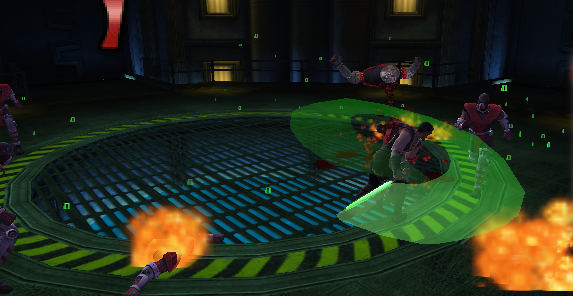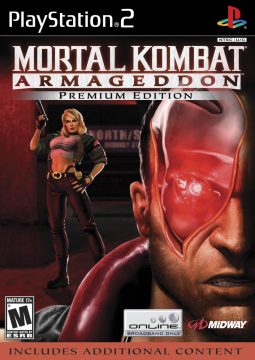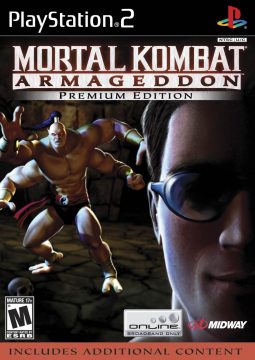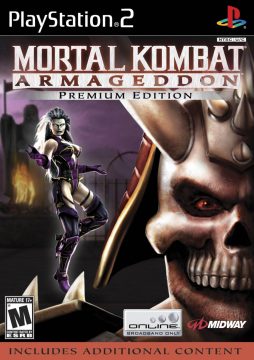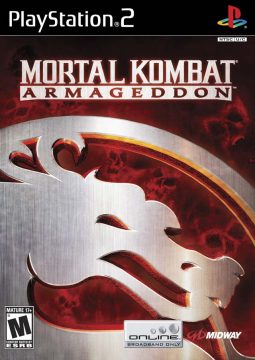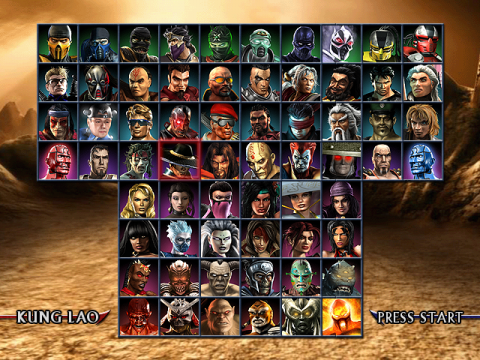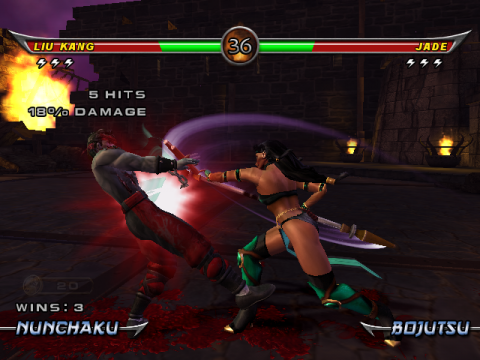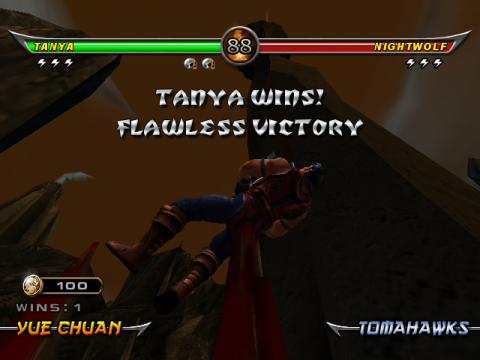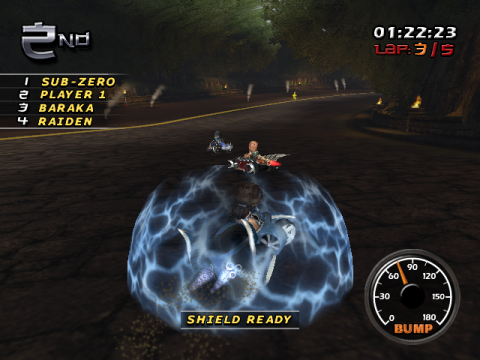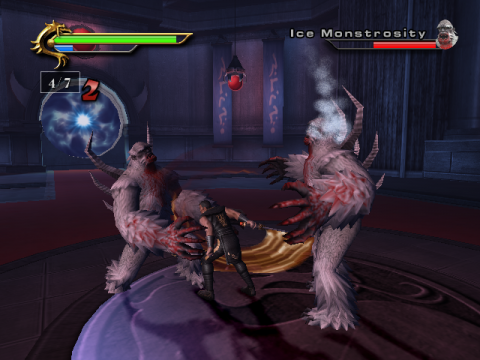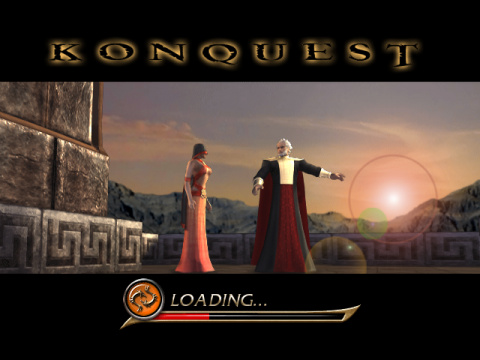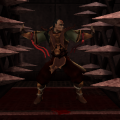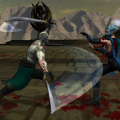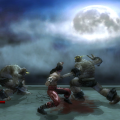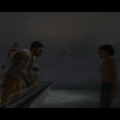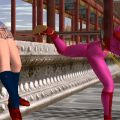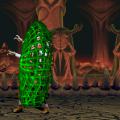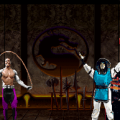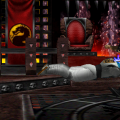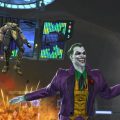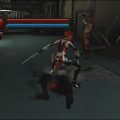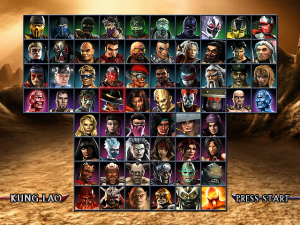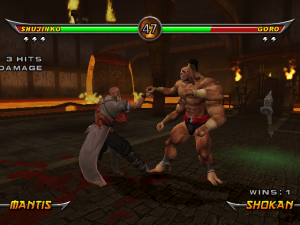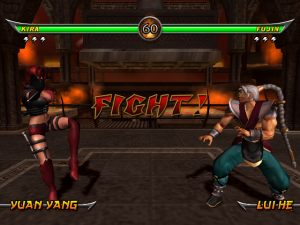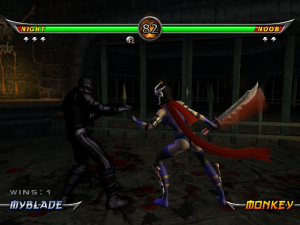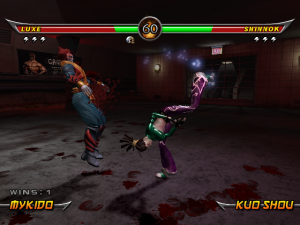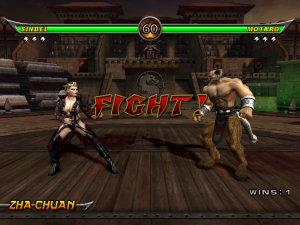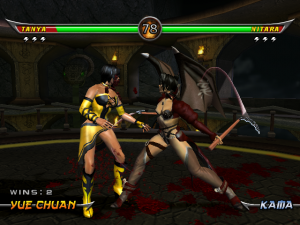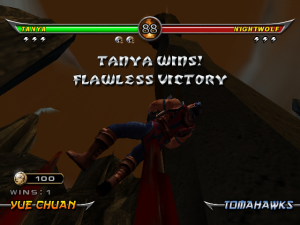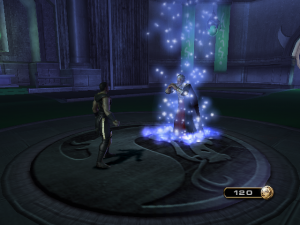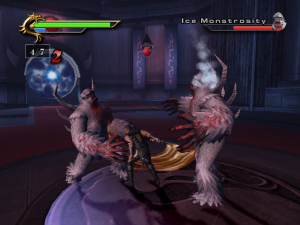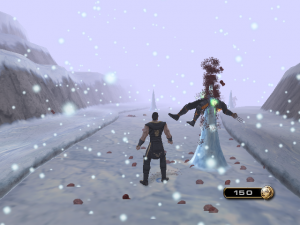- Mortal Kombat (Introduction)
- Mortal Kombat (1992)
- Mortal Kombat II
- Mortal Kombat 3
- Ultimate Mortal Kombat 3
- Mortal Kombat Trilogy
- Mortal Kombat 4
- Mortal Kombat Mythologies: Sub-Zero
- Mortal Kombat: Special Forces
- Mortal Kombat: Deadly Alliance
- Mortal Kombat Deception
- Mortal Kombat: Shaolin Monks
- Mortal Kombat Armageddon
- Mortal Kombat VS DC Universe
- Mortal Kombat (2011)
- Mortal Kombat X
- Mortal Kombat (Miscellaneous)
As new systems like the Xbox 360 and PlayStation 3 appeared on the horizon, developers were slowly starting to move away from the systems of the current generation and onto the next. Before Midway moved on, however, they made one final game for the PS2 and Xbox generation. What they promised was that this would be the final game with the MK kombatants as we knew them, and the next game would start off with an entirely brand new cast. Some people, in fact, took this as the news this would be the final Mortal Kombat entirely. While neither of these ended up happening, this does feel like sort of a big farewell to the series. Obviously, that didn’t turn out to be the case, but if it were, it’d be a pretty awful thing to end such a long running series on.
The Elder Gods have a problem. The kombatants have gotten so powerful and so numerous that their fights are slowly beginning to wear out the fabric of reality, which you would sort of expect to happen when you have fighters who can decapitate people with one punch. Not only that, but the fact that the warriors of light and darkness are having a huge, all-out war isn’t helping with that at all. And so, the Elder Gods cause a huge pyramid to rise out of the ground, with all the fighters running toward it to see what’s at the top. It’s Blaze, given power by the Elder Gods to kill off as many kombatants as possible to prevent the end of the universe. As you can imagine by the title, a whole lot of people are going to die, and this time around, not everybody is going to come back. Shed a tear for poor, poor Mokap.
Just like Trilogy before it, Armageddon is another “Dream Match” style game. Every character who’s been playable in the fighting games so far is back here, which means that there’s an insane 64 total playable characters. Sareena? She’s here. Hsu Hao? Yes, sadly. Meat? Sure, why not. You can even be Motaro, if you don’t mind the fact he’s lost two of his legs. Even the characters who were previously dead have returned for pretty much no reason, just so they can make another appearance and end up dying again. And with a new Konquest mode comes a new character to join all the returning cast, and this time around, he comes with his own evil counterpart!
The fighting mechanics have been revised once more since Deception. Since there’s more than 60 characters, they all only have one hand to hand style and one weapon each. Honestly, the exclusion of a second hand to hand style really only helps the game feel smoother, since you don’t have to memorize three entire lists of moves and combos. On the other hand, though, it does result in less move variety. The chain combos have been shortened ever more since Deception, so that they’re only reach up to three or four hits each. There have been a few minor changes to the combat engine, too. When you get knocked down, you now have a few options: You can either delay getting up, or you can do a quick kick or an uppercut as you get off of the ground, like in pretty much every other popular 3D fighting game. Not a huge gameplay difference, but it’s a decent way to pull a surprise attack on your opponents.
There’s also a new ‘parry’ move, done by hitting back and the block button together. If you can manage to properly time it to an opponent’s attack, you’ll knock them off balance for a chance to counterattack. The timing on these isn’t nearly as strict as say, Street Fighter III: Third Strike, and unlike Combo Breakers, you’re free to parry all you want. They don’t work against special moves, however, so keep that in mind. There’s also a new feature where you can do combos in the air, either by jumping towards an airborne opponent, or popping them into the air and jumping after them, Marvel vs Capcom style. Since you’re still limited to chain combos that can only be performed in the air, however, it doesn’t feel as nearly as smooth as the way as the way Capcom’s VS games handled it.
The problem with a game that has more than 60 characters is that they tend to feel really, really samey. This was an issue with nearly all of the MK games in the past, but it’s even worse here. Most of the fighters tend to share nearly exactly the same animations and more than a few of the moves. The bright side is that some of the characters have gotten a few extra moves, so Hsu Hao is no longer stuck with two special moves like he was in Deadly Alliance. Kira, however, is still generally gimped, especially now that the characters she stole her moves from are in the same game as her. Some of the older characters have also gotten new outfits, including Stryker, who wears a futuristic looking SWAT outfit into kombat.
The stages keep the extra interactivity they got in Deception, including multiple tiers, stage hazards, and death traps. Most of the stages are 3D versions of levels from the classic games, including the Bell Tower, Goro’s Lair, and the Subway. There’s also a few new stages, including Sektor’s new warship. There’s also a stage set in Hell, which is basically an infinite series of platforms that you and your opponent can knock each other onto. There’s still no way to set death traps for the winning round only.
Even the laziest characters at least had their own Fatalities to set them apart from each other in the earlier games, but in Armageddon, they don’t even do that. For whatever reason, probably due to deadlines, nobody has any character specific Fatalities, at all. Instead, there’s a strange new ‘Kreate-A-Fatality’ gimmick that makes you string together moves to finish off your opponent. Once your opponent is dizzy, you have a limited time to put in an input, which is usually two directions and a button press. You only have a limited amount of time to do each move, and with each subsequent move you get less time. What you’re supposed to do is get in as many moves as you can before performing a finisher to end the Fatality.
The chain moves include things like pulling organs out of your opponents, tearing their arms out and whacking them with them, or kicking them in the nuts. You’re also able to put your opponent in different positions, which opens up even more moves. Boss class characters and characters with swords also get some moves only they can perform, but that’s pretty much all you get when it comes to unique moves. You can have up to 11 steps in your Fatality before you end it, but oddly enough, if you don’t actually do one of your finisher moves, it doesn’t actually count as a Fatality. Even if you’ve ripped your opponents heart, brain, and arms out, which most people would consider pretty fatal.
At the end of the arcade mode, you fight Blaze, who’s actually pretty easy to take down. He is, however, a little tougher than Onaga, since you can’t just walk around and shatter things that stun him. He even blows up in the exact same way as Onaga. For an ending, you get to watch your fighter do a kata on top of the pyramid, accompanied by some text and narration. This is all you get for every character; even the nice still images from previous games are gone. Most of the endings for the unpopular characters involve them dying, which, since they’re unpopular, is all right.
There’s a new mode that lets you create your own character, similar to the one seen in Soul Calibur 3. While it’s not as deep as something you’d see in the WWE games, there’s a decent enough variety of parts and clothing options to make decent looking Sephiroths and Strong Bads. In fact, you’re pretty much expected to make Sephiroth, since one of the hairstyles is ripped straight from him. They even call it ‘Fantasy.’ Subtle, Midway. It helps that you’re not limited to medieval-ages clothing like in Soul Calibur 3, which gives you a lot more freedom to make characters. Unfortunately, most of the character parts are locked until you pay enough koins to actually use them. It’s kind of annoying, but since there’s only one type of koin to keep track of now, it’s not nearly as bad as it could have been. What’s really frustrating, however, is that there can be only one character per player profile, so if you want to make and use more than one, you have to swap profiles on the character select screen and remember which profile belongs to whom.
You’re also able to customize your character’s moves, although this is kind of limited. You can select every single one of a character’s basic moves, categorized by the input used to perform them. You can also give your character a projectile, a charge move, a disabling move, a teleport, and a throw, all of which are taken from the other characters’ move sets. Unfortunately, there aren’t any special moves that don’t fall under one of those five classes, which means most created characters are going to feel pretty smilar. Weapon types are also severely limited: If it isn’t something that can be swung like a sword, you can’t use it. This only leaves generic swords, maces, and axes, which gets boring pretty fast.
Just like Deception had a minigame that ripped off a much better game, Armageddon has Motor Kombat. It’s basically the Mario Kart to Puzzle Kombat‘s Puzzle Fighter. You can chose from a bunch of superdeformed Mortal Kombatcharacters, who each have a personalized vehicle to race in. Johnny Cage gets a sports car, Jax has a miniature tank, and Bo Rai Cho races around in a beer keg. It’s a pretty sub-standard racing game, with only a few tracks to race on. There’s also hazards scattered all over the track, like a gong you can drive through to make iciciles fall onto the other racers. Unlike Mario Kart, things tend to end rather bloodily for anybody who gets hit with a hazard, but anybody who gets killed will pop back onto the track just a few seconds later.
There’s only a couple of powerups on the track, compared to the multitude of items you’d be able to use in Mario Kart. Lightning bolts give a brief turbo boost, while stars let you use your character’s special ability. Every racer has one item they can use, and only one, which means that Kitana and her shield probably aren’t going to be very useful compared to Johnny Cage’s projectile. You can also bump to either side to hit the other racers, possibly knocking them into a hazard if you can time it right. Motor Kombat is generally best avoided if you have any other kart racers in your game library. While it’s definitely better than, say, M&Ms Racing, it still feels kind of slapped together, and the time spent making it should have gone towards the fighting engine instead.
The Konquest mode returns, and it’s been majorly improved since the boring faux-RPG it was in Deception. This time around, it’s been turned into a brawler, something closer to Shaolin Monks or God of War. It starts off with Taven’s parents expositioning about a quest that he and his brother Daegon have to undergo to see who will succeed their father as the protector of Edenia. Apparently, their plan is to put a sleep spell on both their sons and encase them in stone, until it’s time for them to race to the pyramid that was built by their father Argus and defeat Blaze. When Taven is woken up a short time after his brother, he’s directed towards a temple dedicated to Argus, somewhere in a jungle in Earthrealm.
While he manages to make it to the temple and receive a message from his father, he ends up getting captured and interrogated by Sektor. An attack on Sektor’s warship by the Special Forces allows Taven to fight his way off, but things quickly start to go south from there. The story is decent enough for what it is, and it helps that Taven is way less of a doormat that Shujinko.
Taven starts off with a decent variety of moves, like being able to do a quick three-hit punch combo, a roundhouse kick that knocks enemies away from him, a throw, and a few moves that launch opponents into the air so he can juggle them. Over the course of the Konquest mode, you’ll also unlock new special moves that can be used against the basic mooks, like a firey ground pound and a projectile. These special moves tend to do a lot of damage, but they’re limited by a meter that gets recharged when Taven lands hits on enemies. Sometimes enemies may get dizzied, giving Taven the opportunity to do a Fatality on them and recharge his special meter. These aren’t anything special, though, just quick finishers like uppercutting an enemy’s head off or impaling them on Taven’s fist. Every once in a while, you’ll also come across weapons that you can use in a certain area, like a hammer that smashes enemies into a red paste with a single blow, or a light saber.
For the most part, fighting with the mooks is pretty fun. Enemies don’t take much punishment before they die, and your special moves will generally tear right through them. It’s a good thing, too, since you’re usually put in situations where you get trapped somewhere and have to kill a ton of enemies to make your way out. The further you go, the tougher enemies you come across, and they go from simple punching and kicking to throwing grenades at you. There are also times you run into one of the other playable characters, and when this happens, the game switches to the main fighting engine.
In between fighting with mooks, occasionally Taven comes across hazards to avoid, like statues that shoot out spinning blades and spiked crushers. Unlike the Konquest mode in Deception, it’s entirely possible for Taven to die, either through running out of health or through one of the many, many traps and hazards, and if he does, he’ll get kicked back to the last checkpoint he reached.
Konquest mode only takes about two or three hours to finish, maybe a little less, depending on your skills. It’s not overly challenging, aside from a few points when it’s especially difficult to avoid the many, many one hit kill hazards. If it were a stand-alone product, it wouldn’t be nearly as good, but as a distraction from the main fighting mode, it does a pretty good job. It definitely manages to outclass Mythologies and Special Forces, at the very least.
The Krypt also returns, although it’s much, much smaller than the ones in Deadly Alliance and Deception. This time around, there’s only one type of coin, meaning you don’t have to grind nearly as much to buy the stuff you want. Actually, you barely even have to go into the Krypt, since you can unlock pretty much everything through the Konquest mode. There’s 60 relics hidden throughout the mode, and for every 10 you collect, you’ll unlock a new reward. They’re not that difficult to find, and if you manage to get all 60, you’ll instantly unlock everything in the Krypt. Or, if you’re really lazy, you can just use traditional cheat codes to unlock the stuff you want, something that wasn’t an option in Deadly Alliance or Deception. Your coins are much better spent on the character creation parts, most of which are locked at the start of the game.
Overall, Armageddon isn’t that much of a step up from Deception. It’s nice to see so many forgotten characters return, but the fact that they feel all so similar kind of diminishes the “big finale” feel the game has going for it. There are some minor engine tweaks that make the game feel a little more fresh, but it isn’t really enough. Konquest Mode is actually pretty fun, compared to the snoozefest it was in the previous two games, but Motor Kombat is just too limited to be any real fun. With the next generation, however, would come some badly needed change. Possibly even a little too much change, given the subject matter of the next game In the series.
The PS2 and Xbox versions are mostly identical, except that the Xbox one has support for four players in Motor Kombat as opposed to just two – if you’re really that desperate for a mediocre kart racer, of course. The Wii version, released some time after the others, has a few extras, once again at the cost of online play – which the Wii actually supports, so who knows why it wasn’t included here. Besides being able to use the GameCube and Classic controllers, you can use motion controls for special moves and Fatalities, which is probably a terrible idea in actual practice. It also has Khameleon, the female ninja from the Nintendo 64 version of Mortal Kombat Trilogy, as a playable character. There’s also a new Endurance mode which works the same way as your average survival mode.
